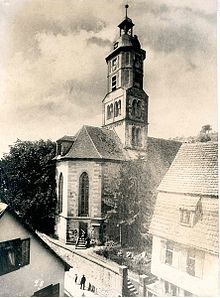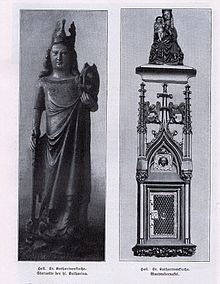St. Katharina (Schwäbisch Hall)
The Evangelical Parish Church of St. Katharina is a sacred building in Schwäbisch Hall , which is to the left of the stove . Until 1404 it was a branch of Westheim , until 1526 it was under the patronage of the Murrhardt Monastery . In 1405 it became an independent parish church and came into the possession of the city of Hall with the Reformation in 1526.
history
Already around 900 there was a flat-roofed single-nave hall building with 3 apses at the site of today's church. The new church was donated by the Barons von Westheim around 1240. The east wall of the old building was demolished, and a transept with a crossing tower and semicircular apse was built in the late Romanesque style. In 1343 the apse was demolished and a Gothic choir was built. At the same time, the nave was given a steeper roof and large Gothic windows. The Dutch high altar was built around 1450. After the Reformation, galleries were built in the choir and nave in 1597. In 1570 the church tower was raised with a half-timbered structure, and in 1727 it was made of solid stone with two octagonal floors with a dome roof. In 1859 the medieval art monuments in the church were restored under the parish priest Heinrich Merz .
From 1896 to 1898, the Stuttgart architect Heinrich Dolmetsch had the nave demolished and replaced with a much larger neo-Gothic nave and two sacristies added. The two lower tower floors above the crossing, dating from the 13th century, as well as the two floors above, which were added in 1727, were left. The Gothic choir was also left untouched. The churchyard walls were torn down. The interior of the church was redesigned in 1961 by the architect Eduard Krüger and given a wooden barrel vault.
In 1961 the interior was opened by Dr. Eduard Krüger completely redesigned.
Furnishing
Mural (1470)
A medieval mural has been preserved on the east wall and shows Christ on the way to the crucifixion. The other murals had fallen victim to a restoration of the nave in 1844 when the walls were plastered without damage to the old murals. The painting escaped the action because it had already been whitewashed in 1688. It was rediscovered in 1854 by pastor Heinrich Merz, who had it restored by the painter Eberlein from Stuttgart (Nuremberg).
Stained glass
Ten glass pictures were put together in the southern choir window in 1900. The ten medieval glass paintings from around 1340–50 form two stylistic groups that originally belonged to two different windows.
The first group comprises eight figures, which stand on a blue ground in damascus vines in yellow-tinted high Gothic arcades and are bordered on the sides by blue-red ribbons with lily patterns. There are six figures of virtues victoriously trampling down vice , each marked with a name by a banner, as well as St. Dorothea and Margaret.
The second group consists of two pictures: St. Catherine in front of the Scholars of Alexandria and Purgatory , both in medallions on a diced background.
Altars
In the choir of the church is the original altar, an imported piece from the Netherlands. The shrine and the sculptures were created around 1449 in the workshop of Willem Ards in Leuven , the paintings of the wings before 1450–51 in Leuven.
In the sacred three altars from the 14th century were originally present, the Lady altar , the Erhard altar and the locust altar , finally, a Annenaltar , probably from the 15th century, which have not survived.
Mount of Olives Scene (1470)
The Mount of Olives scene was once on the south wall of the sacristy, outside the church. In 1843 this should be completely removed, but the sacristan was able to bring the figures - John, James and Peter as well as Jesus - to safety beforehand. They were placed in the church after a restoration. In 1898 the figures were cleaned by the painter Haffner, the colors were improved. Gottfried Schmidt painted “Jerusalem” on the background. In 1906 the sky and the soldiers were painted again by Schmidt.
Holy Sepulcher (1470)
The center of the scene is the body of Christ on a stone tumba , flanked by the tomb guards consisting of the figures of Joseph and Nicodemus. There are two warrior figures on the front wall of the tumba. In the background four figures, Johannes, Maria, Maria Magdalena and a third female figure.
Pulpits (1694/1695 and 1898)
The church originally had an old baroque pulpit from 1694/1695, which was replaced in 1898 by the neo-Gothic "interpreting pulpit". This was created by Georg Rößler from Untermünkheim and Georg Lehnert from Gelbingen based on the design by Dolmetsch. In 1961 the neo-Gothic pulpit was exchanged for the old baroque pulpit, which had since been relocated.
Wall Tabernacle (1420)
The medieval wall tabernacle is 252 cm high and 100 cm wide and is stylistically related to the wall tabernacle in St. Urban . In the eyelash an angel is depicted in full plastic, holding Veronica's handkerchief.
Baptismal font (1450) and baptismal lid (1694)
The font is three-sided. The sides are worked out as Gothic windows with keel arches and finial. In 1688 half-length portraits of Jesus and the twelve disciples were painted on.
literature
- Eugen Gradmann : The art and antiquity monuments of the city and the Oberamt Schwäbisch-Hall . Paul Neff Verlag, Esslingen a. N. 1907, OCLC 31518382 , pp. 40-50 ( archive.org ).
- Eduard Krüger: Schwäbisch Hall. A walk through history and art. 3rd edition, revised by Fritz Arens and Gerd Wunder. Eppinger-Verlag, Schwäbisch Hall, 1982, pp. 106-109.
- Wolfgang Deutsch: The high altar of the Haller Katharinenkirche. History and origin. In: Württembergisch-Franken. Yearbook. Vol. 69, 1985, ISSN 0084-3067 , pp. 127-220.
- Dagmar Zimdars among other things: Handbook of German art monuments . Baden-Württemberg. Volume 1: The administrative districts of Stuttgart and Karlsruhe. Deutscher Kunstverlag, Munich et al. 1993, ISBN 3-422-03024-7 , pp. 684–685.
- Wolfgang Deutsch among others: The Michaelskirche in Schwäbisch Hall. A companion through the medieval churches of St. Michael, Urbanskirche and St. Katharina. 2nd, improved and enlarged edition. Fink, Lindenberg 2004, ISBN 3-89870-075-5 .
- Hans Werner Hönes: Katharinenkirche Schwäbisch Hall. Epitaphs, tombs, panel paintings, memorial and donor tablets. In: Württembergisch-Franken. Yearbook. Vol. 90/91, 2006/2007, pp. 227-278.
Web links
- Sights in Schwäbisch Hall: St. Katharina
- The Katharinenkirche in Schwäbisch Hall
- Photo of the interior with a view of the choir with altar shrine
- Parish of St. Michael and St. Katharina
- St. Katharina (Schwäbisch Hall) - Entry at Kirchenbau Deutschland
Individual evidence
- ^ Eduard Krüger: Schwäbisch Hall. A walk through history and art. 1982, p. 106.
- ↑ a b c d e f g Hans Werner Hönes: Katharinenkirche Schwäbisch Hall. The works of art and their restorations. The changing locations of the works of art and their restorations over the centuries. City of Schwäbisch Hall, Schwäbisch Hall 2007, ISBN 978-3-932146-26-8 .
- ↑ Wolfgang Deutsch: The high altar of the Haller Katharinenkirche. History and origin. In: Württembergisch-Franken. Yearbook. Vol. 69, 1985, ISSN 0084-3067 , pp. 127-220; Evelyn Bertram-Neunzig: The grand piano retable on the high altar of St. Reinoldi Church in Dortmund. Investigations into its shape, iconography and origin. Dissertation, University of Cologne 2004, pp. 226–229 with literature. Full text .
- ↑ Wolfgang Deutsch: The high altar of the Haller Katharinenkirche. History and origin. In: Württembergisch-Franken. Yearbook. Vol. 69, 1985, pp. 127-220, here p. 131.
Coordinates: 49 ° 6 ′ 38.7 " N , 9 ° 43 ′ 55.4" E




